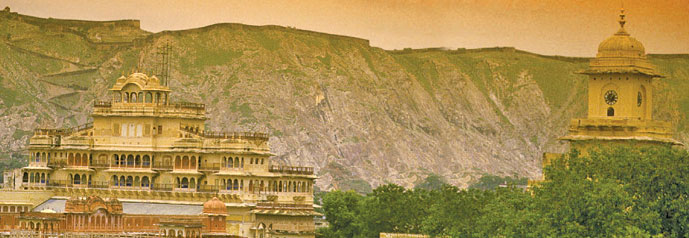

Founded in 1727, Jaipur is popularly known as the Pink City and the capital city
of Rajasthan. Known as the Pink City because of the colour of the stone used exclusively
in the walled city, Jaipur had once been the capital of the royalty and its very
structure resembles the taste of the Rajputs and the Royal families. The city was
planned according to Indian Vastu Shastra built in the form of an eight-part Mandala
known as the 'Pithapada'. Beautiful constructed palaces, havelis and forts dot this
Pink City, which was planned by Vidhyadhar Bhattacharya, a Bengali architect in
a grid system with wide straight avenues, roads, streets and lanes and uniform rows
of shops. Jaipur’s architectural planning may have been ancient, but its execution
was superbly modern. All of Jaipur is an architectural gem, and this fascinating
city with its romantic appeal takes you to an era of royalty and tradition. Jaipur
is an attractive creation worthy of universal admiration and comfortable and luxurious
hotels, once the pride of maharajas and royals make this Pink City a tourist's paradise.
After all, in the 2008 Conde Nast Traveller Readers Choice Survey, Jaipur was ranked
the 7th best place to visit in Asia.
Eating Out!
Jaipur has a myriad number of restaurants that offer delicious food. The city which
has served Kings and Queens of Royal Families has a lot of cuisine to offer that
are both enjoyable and delectable. Hotels like Umaid Bhawan and The Raj Palace offer
an ambience that is fit for royalty.
SpiceJet Recommendations!
City Palace; Jantar Mantar (Observatory); Hawamahal & Jalmahal; Amer Fort; Central
Museum; Birla Planetarium; Kanak Vrindavan; Nahargarh Fort.
Nirvana Organic Resort
Jaipur
- Hawa Mahal
The Hawa Mahal is easily the most strikingly designed monument in Jaipur. Built
by the poet king Sawai Pratap Singh in 1799, this five storied stunning semi-octagonal
monument having 152 windows with over hanging latticed balconies is a fine piece
of Rajput architecture. Sireh Deorhi Bazaar is the five story high backside of the
complex, and was conceived to provide adequate vantage position behind delicate
stone carved jali screens to the royal ladies for watching processions passing through
the bazaar below.
- Jantar Mantar
Built in 18th century by Maharaja Sawai Jai Singh II, Jantar Mantar, a UNESCO world
heritage site, is one of Jai Singh's five remarkable observatories. Constructed
with stone and marble, its complex instruments has settings that are scientifically
designed representing Medieval Indian astronomy and are used to study the movement
of constellations and stars in the sky. Huge sun-dial still provide accurate time;
subject to daily minor corrections though. The Ram Yantras used for gauging altitudes
are distinctive in their isolation.
- Albert Hall Museum
The oldest museum of the state that functions as the State museum of Rajasthan,
the Albert Hall Museum is situated in Ram Niwas Garden outside the city wall opposite
New Gate. Designed by Sir Samuel Swinton Jacob and opened as public museum in 1887,
it is a fine example of Indo-Saracenic architecture. It is also called the Government
Central Museum and has a rich collection of artefacts like paintings, carpets, ivory,
stone, metal sculptures, and colourful crystal works.
- Lakshmi-Narayan Temple
Situated in the southern horizon is a privately owned hilltop fort of Moti Doongari
resembling a castle in Scotland. And the Birla Mandir or the Lakshmi-Narayan Temple
is situated just below the Moti Dungari and is a modern temple built of white marble.
The three domes of the temple portray different approaches to religion. The presiding
deities here are Lord Vishnu (called Narayan) and his consort Goddess Lakshmi of
wealth and good fortune. Built on raised ground, it is surrounded by large lush
green gardens and is a sheer poetry in stone.